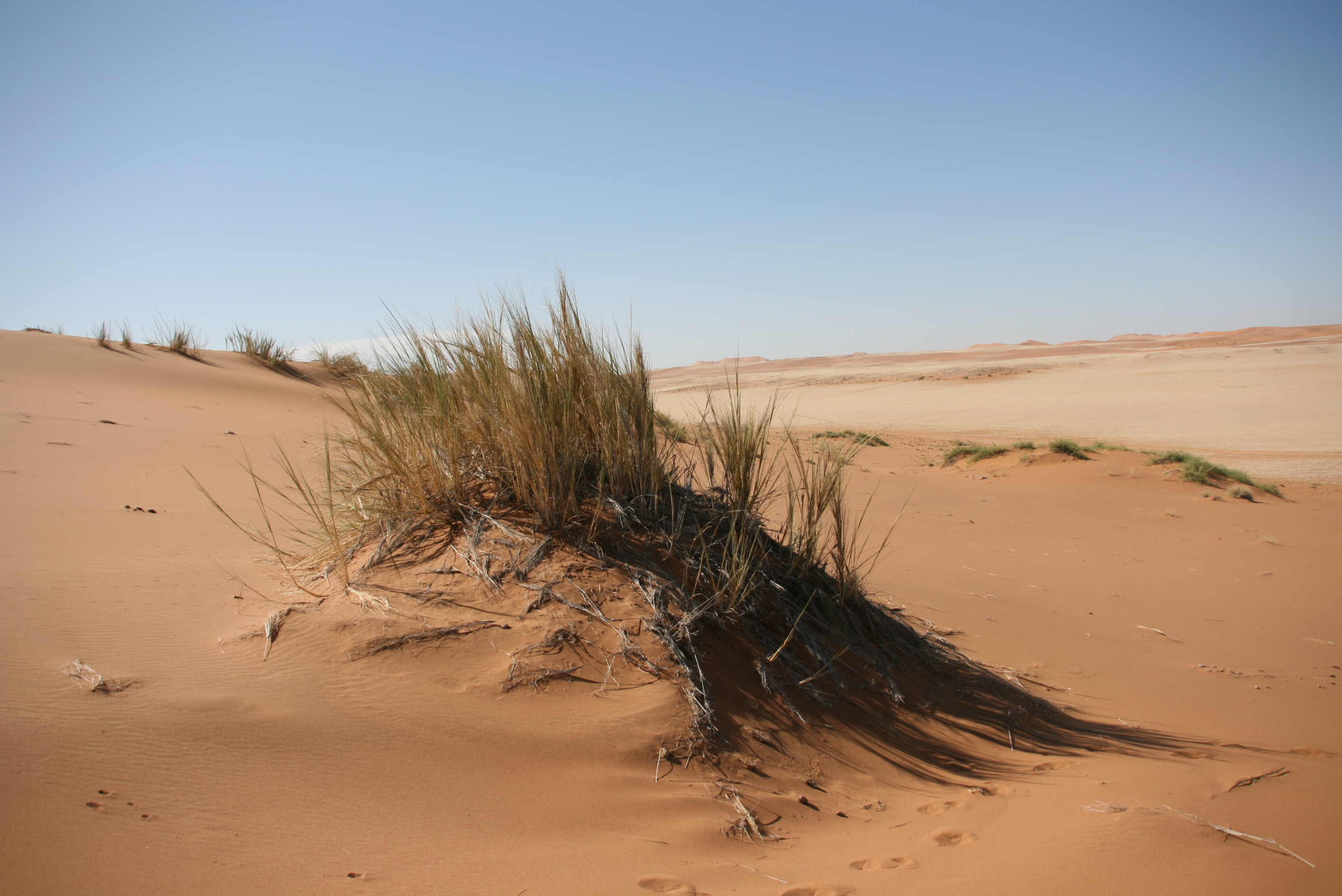News
04.07.2024
Grasses in the Fog: Plants Support Life in the Desert
Complex food chain in the Namib Desert decoded
Researchers from the Senckenberg Centre for Human Evolution and Palaeoenvironment (SHEP) at the University of Tübingen and the Senckenberg Natural History Museum in Görlitz have studied the role of the desert grass Stipagrostis sabulicola in the African Namib Desert. In their study, published in the journal Scientific Reports, they show that the plant is able to absorb moisture from fog events and thus forms an essential basis of an – altogether unexpectedly complex – food web in the drought-stricken landscape.
The word Namib means something like “the place where there is nothing” or simply “wide open space” – not entirely accurate, because in the Namib Desert on the southwest coast of Africa, a considerable number of animal and plant species have adapted to the extreme environment with hyper-arid conditions and sandy expanses stretching some 2,000 kilometers from north to south. “Stipagrostis sabulicola, the Namib dune bushman grass, is one such plant species that is native to the Namib Desert,” explains Dr. Huei Ying Gan from the Senckenberg Centre for Human Evolution and Palaeoenvironment at the University of Tübingen. Together with the study’s two other main authors, Dr. Karin Hohberg and Dr. Clément Schneider from the Senckenberg Natural History Museum in Görlitz, as well as other researchers from the University of Tübingen, the two Senckenberg Institutes, and the Gobabeb Namib Research Institute, Gan studied the perennial grass, which can reach up to two meters in height, and its role in the desert ecosystem.
The plant has a broad system of shallow roots that enable it to anchor itself effectively in the dune. “In addition, Stipagrostis sabulicola has specialized leaf structures that are very effective at condensing moisture from the air in the form of fog and dew. This is very important because fog from the Atlantic Ocean, averaging 39 millimeters per year, is a more regular source of moisture than rain, which averages only 17 millimeters per year at the study sites,” continues the biogeochemist from Tübingen.
The fog forms when the warm, humid Atlantic air flowing in from the west cools down over the cold ocean surface off the coast – depending on altitude and wind conditions, this advection fog can travel for many kilometers into the interior of the Namib Desert. “As soon as the fog touches the ground, the endemic desert grass captures the moisture from the fog and channels it into the sand,” adds Hohberg.
In their new study, the researchers show that the fog-harvesting grass thus constitutes an important ecological niche – the so-called “fog plant oases” – also serves as a primary carbon source for invertebrates. To determine the latter, the team measured the natural variations in stable carbon and nitrogen isotopes (δ13C and δ15N) of invertebrates as well as plant biomass and litter in the soil and assessed the proportion of fog plants in their diet. “Our results show that the bushman grass of the Namib Desert promotes carbon flow in the food web. We were able to demonstrate that the plant is the primary food source for above-ground invertebrates such as ants, spiders, pseudoscorpions, and mites – we found twelve species of arthropods on the leaf surface and in the leaf sheaths alone, along with an additional seven species that we did not study in detail,” says Schneider.
According to the scientists, the situation is different for organisms living in the soil, such as nematodes: Here, the wind-blown sediments carried into the soil appear to serve as the main source of energy. “Overall, however, it can be said that the importance of Stipagrostis sabulicola goes far beyond the invertebrate food web. This is because numerous arthropods, such as weevils and black beetles, which are dependent on the grass as an energy source and therefore live in close relationship with the plants, serve as a vital food source for more mobile predators such as sand lizards, nursery web spiders, or the dune lark. In the higher food chain, the lizards, in turn, are an important food source for the adder species Bitis peringueyi. Our analyses underline the crucial role of fog plants in the hyper-arid Namib dunes,” adds Gan in summary.
Website of the Senckenberg Gesellschaft für Naturforschung:
https://www.senckenberg.de/en/pressemeldungen/grasses-in-the-fog-plants-support-life-in-the-desert/
Publication:
Gan, H.Y., Hohberg, K., Schneider, C. et al. The hidden oases: unveiling trophic dynamics in Namib's fog plant ecosystem. Scientific Reports 14, 13334 (2024), https://doi.org/10.1038/s41598-024-61796-8
Contact:
Dr. Huei Ying Gan
Senckenberg Centre for Human Evolution and Palaeoenvironment (SHEP) at the University of Tübingen
huei-ying.ganspam prevention@senckenberg.de
Judith Jördens
Press Office
Senckenberg Gesellschaft für Naturforschung
Phone +49 69 7542-1434
Pressestellespam prevention@senckenberg.de

